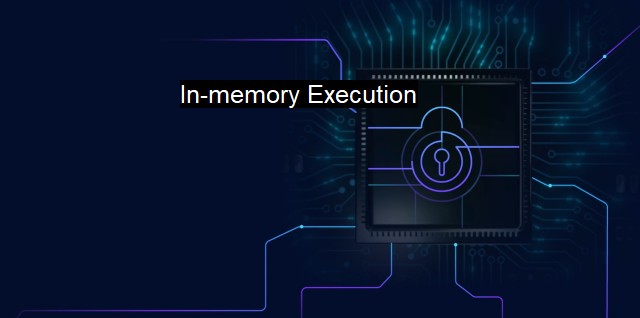What is In-memory Execution?
Unleashing Stealth Attacks: The Advantages of In-Memory Execution for Cybercriminals
In-memory execution represents a striking technique used in the world of cybersecurity and antivirus that fundamentally focuses on running a piece of code or program entirely from the system's RAM. Contrary to traditional procedures where programs are executed from the hard drive, this technique allows for swift, efficient and evasive operations that tend to be overlooked by standard monitoring protocols thereby posing critical security threats.Deploying routines directly into memory make them elusive to on-disk antivirus detections, and they remain predominantly abstracted from writing to the disk. When malicious exploits are implemented into volatile memory without ever touching the hard drive, they keep themselves concealed thereby significantly reducing the odds of detection.
In-memory execution posits unique challenges for cybersecurity as coded procedures are unsurpassed in sustaining their disruptive nature. Conventionally, antivirus solutions examine the physical drive to discover and ward off potential threats; conversely, in-memory attacks evacuate the hard drive entirely leaving scant traces of their existence. Hence, actuating stringent security protections against such threats becomes substantially arduous.
To elaborate, suppose the misfeasor initiates a harmful software, the malware will generally infiltrate the memory components, copy its malicious code directly into RAM and execute the attack from there. As memory is routinely and rapidly cleared on system reboots or shutdowns, it eliminates potential traces of the malware essentially indicating an uncomplicated clean slate post any malevolent undertaking.
In-memory exploits also manifest themselves in the form of living-off-the-land (LotL) attacks, where the culprits manoeuvre legitimate system tools to carry out malicious operations thus convoluting the distinction between harmful and usable activities. PowerShell scripts or Windows Management Instrumentation (WMI) are predominant conduits for in-memory misdemeanours designed to tamper with healthy system processes in erratic ways, which makes them particularly hard to trace.
While this might indicate a disconcerting picture for cybersecurity professionals, it's also stirred innovation for advanced mechanisms to counter in-memory executions. Detecting such movements requires scrutinizing the system’s memory for any anomalies rather than concentrating solely on drive-based forensics. There are now tools and access methods available that accommodate real-time scanning of memory, providing effective ways to identify and mitigate threats.
End-point detection and response solutions (EDR) depict a format of defence that predicates its actions on monitoring system behaviour as opposed to relying on signature-based detection strategies. This next-generation innovation scrutinizes a security incident ply by ply and hunts for subtle anomalies that could unravel an otherwise latent and against the grain security attack making it an ideal tool to tackle these in-memory execution threats.
It's crucial to remember, though, that thwarting in-memory execution as an apparatus for potential destructive campaigns does not imply forbearance from this technological brilliance when implemented for worthy cause. When proficiently and ethically leveraged, in-memory execution magnifies technological productivity by enabling faster data fetches and smoother system operations.
It’s because of these enhancements that blooming technologies like data-intensive applications, machine learning & AI leans on in-memory executions. Performance-intensive applications benefit immensely from these executions since it eliminates the need for swapping data in and out of RAM regularly, promoting faster operation.
Conclusively, in-memory execution, albeit an unnerving technique in adverse hands, portrays twin edges in deciphering its utility. Wherein on one side, cyber-criminals exploit it to conceal and execute malevolent activities, the brighter side pronounces its immense potential in pushing the boundaries of conventional computing expediency. Therefore, as cyber-security evolves, virtualization advancements must march in pace to curtail the former while concurrently maximising the technology's overall potential.

In-memory Execution FAQs
What is in-memory execution in the context of cybersecurity?
In-memory execution is a technique used by some malware to avoid detection by antivirus software. It involves loading malicious code directly into a computer's memory instead of writing it to a file on the hard drive. This makes it more difficult for antivirus software to detect and remove the malware.How does in-memory execution work?
In-memory execution works by loading code directly into a computer's memory, where it can be executed without being written to a file on the hard drive. This makes it more difficult for antivirus software to detect the malware because the code is not stored in a detectable location.What are the risks of in-memory execution for cybersecurity?
In-memory execution can pose a significant risk to cybersecurity because it allows malware to execute without being detected by antivirus software. This can lead to data theft, system damage or unauthorized access to sensitive information.How can you detect in-memory execution?
Detecting in-memory execution requires specialized antivirus software that is designed to look for malware that is loaded directly into a computer's memory. This software can detect and remove malware in real-time, before it has a chance to cause damage to the system. Other detection methods include analyzing system logs or using intrusion detection systems that can identify suspicious network activity.| | A | | | B | | | C | | | D | | | E | | | F | | | G | | | H | | | I | | | J | | | K | | | L | | | M | |
| | N | | | O | | | P | | | Q | | | R | | | S | | | T | | | U | | | V | | | W | | | X | | | Y | | | Z | |
| | 1 | | | 2 | | | 3 | | | 4 | | | 7 | | | 8 | | |||||||